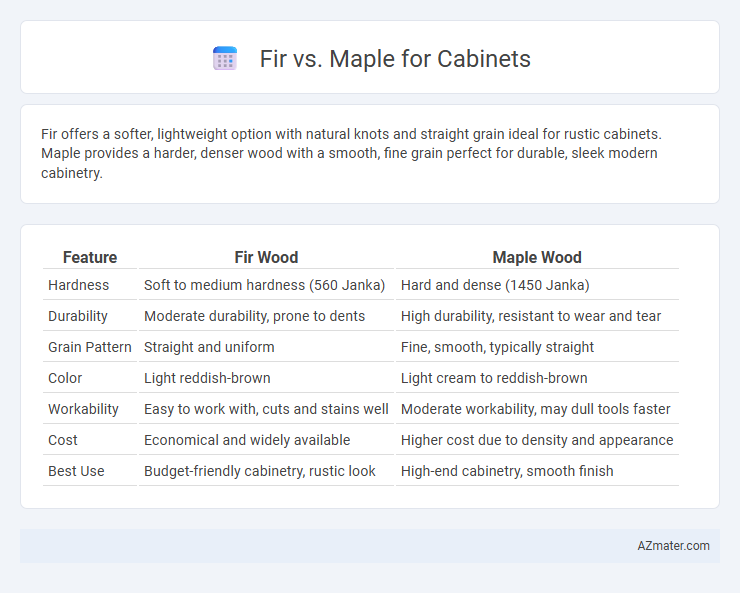Fir offers a softer, lightweight option with natural knots and straight grain ideal for rustic cabinets. Maple provides a harder, denser wood with a smooth, fine grain perfect for durable, sleek modern cabinetry.
Table of Comparison
| Feature | Fir Wood | Maple Wood |
|---|---|---|
| Hardness | Soft to medium hardness (560 Janka) | Hard and dense (1450 Janka) |
| Durability | Moderate durability, prone to dents | High durability, resistant to wear and tear |
| Grain Pattern | Straight and uniform | Fine, smooth, typically straight |
| Color | Light reddish-brown | Light cream to reddish-brown |
| Workability | Easy to work with, cuts and stains well | Moderate workability, may dull tools faster |
| Cost | Economical and widely available | Higher cost due to density and appearance |
| Best Use | Budget-friendly cabinetry, rustic look | High-end cabinetry, smooth finish |
Introduction to Fir and Maple Wood for Cabinets
Fir wood, known for its straight grain and moderate hardness, offers a sturdy and cost-effective option for cabinet construction, often appreciated for its smooth finish and ease of staining. Maple wood, characterized by its fine texture and high durability, provides a dense, hard surface that resists dents and scratches, making it ideal for long-lasting cabinetry with a clean, elegant appearance. Both woods are popular choices in cabinetry, with fir favored for rustic, affordable designs and maple sought after for premium, refined aesthetics.
Key Differences Between Fir and Maple
Fir wood, known for its lower density and softer texture, offers ease in cutting and shaping, making it ideal for rustic or budget-friendly cabinets. Maple, a hardwood with a tight grain and high durability, provides a smooth, fine finish and superior resistance to dents and scratches, suitable for high-end cabinetry. The key differences lie in fir's affordability and workability versus maple's strength, hardness, and elegant appearance.
Aesthetic Appeal: Grain Patterns and Colors
Fir offers a straight, uniform grain with a warm, reddish-brown hue that complements rustic and traditional kitchen designs. Maple features a smooth, fine grain with lighter, creamy tones ranging from nearly white to pale golden, ideal for modern and contemporary cabinets. Both woods provide distinct aesthetic appeal, where fir emphasizes natural warmth and texture, while maple offers a clean, subtle elegance.
Durability and Strength Comparison
Fir and maple both offer sturdy options for cabinetry, but maple is often preferred for its superior hardness and durability, ranking higher on the Janka hardness scale with a rating of about 1450 compared to fir's softer 570. Maple's dense grain structure provides greater resistance to dents and scratches, making it ideal for high-traffic or heavily used cabinets. Fir, while less durable, is still valued for its stability and ease of finishing, but it may show wear more quickly in demanding environments.
Workability and Ease of Finishing
Fir wood offers excellent workability with its straight grain and softer texture, allowing for easy cutting, shaping, and sanding, making it a preferred choice for intricate cabinet designs. Maple's dense, hard grain provides durability but can be more challenging to machine and may require sharper tools, though it finishes smoothly to a fine, polished surface. Both woods accept stains and finishes well, but maple's tighter grain results in a more uniform, glossy finish compared to fir's more rustic appearance.
Cost and Budget Considerations
Fir wood generally offers a more budget-friendly option for cabinets compared to maple, as it is often less expensive due to its faster growth rate and wider availability. Maple, known for its durability and fine grain, commands a higher price but provides long-term value through resistance to dents and scratches, potentially reducing maintenance costs over time. Choosing fir can be cost-effective for those prioritizing initial expense, while maple suits projects where investing in longevity and a premium finish justify the higher upfront cost.
Environmental Impact and Sustainability
Fir cabinets are often praised for their rapid growth and abundance, making fir a more sustainable choice due to shorter harvesting cycles and lower environmental impact. Maple wood, while durable and aesthetically pleasing, typically requires longer growth periods, leading to a higher environmental footprint in terms of land use and carbon sequestration. Choosing fir over maple for cabinetry supports resource efficiency and promotes sustainable forestry practices.
Maintenance and Longevity
Fir cabinets require regular sealing and occasional refinishing to prevent moisture damage and maintain their appearance, while maple cabinets are naturally denser and more resistant to dents and scratches, offering superior durability with minimal upkeep. Maple's tight grain structure makes it less prone to warping, contributing to its long-term stability compared to fir, which may need more frequent repairs in high-humidity environments. Choosing maple cabinets ensures a longer lifespan with lower maintenance costs, whereas fir demands consistent care to preserve its aesthetic and structural integrity.
Best Applications for Fir and Maple Cabinets
Fir cabinets excel in structural stability and resistance to warping, making them ideal for kitchen and bathroom cabinetry where moisture levels fluctuate. Maple cabinets provide a smooth, fine grain with excellent durability, perfect for high-traffic areas such as living rooms and office spaces that demand both aesthetic appeal and longevity. Selecting fir is advantageous for traditional, rustic designs, while maple suits modern, clean-lined interiors due to its uniform texture and ability to take stains evenly.
Making the Right Choice: Fir vs Maple for Your Cabinets
Fir offers a distinctive grain pattern and a softer texture, making it a cost-effective option for cabinets with a rustic or natural look, while Maple stands out for its durability, smooth finish, and resistance to dents and scratches, ideal for high-use kitchen cabinetry. Choosing between Fir and Maple depends on factors such as budget, desired aesthetic, and long-term durability requirements. Maple's dense hardness ensures longevity and minimal maintenance, whereas Fir's lightweight nature allows easier handling and quicker installation.

Infographic: Fir vs Maple for Cabinet
 azmater.com
azmater.com